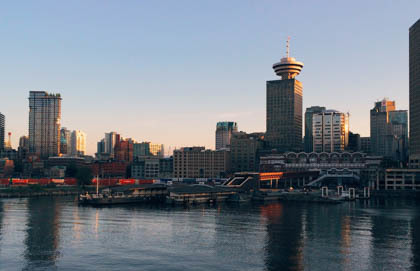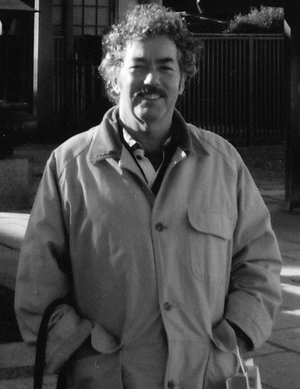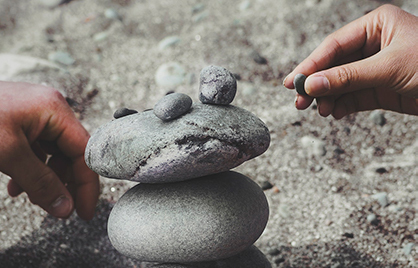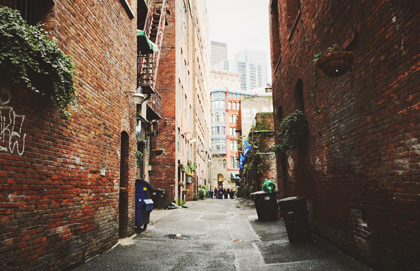Vancouver writer, teacher and Buddhist eco-activist Trevor Carolan recalls how an interfaith protest group, formed in reaction to anti-Christian art, grew to become a vibrant comm unity that shared faith in common life
A few years ago, I inadvertently found myself involved in a major interfaith campaign against Vancouver's downtown civic art gallery. It centred on a nasty event, one of those things that aren't supposed to happen in an enlightened, self-congratulatory city like ours. While escorting a class of university students to an exhibition of Goya's "The Disasters of War" print series, we came upon several photographs by a New York artist, Andres Serrano. Known as the "Piss Pope" series, they were warmly lit and mounted among the Goyas on display. The photographs purported to represent an image of an Italian pope who was soaked in a beaker of urine. What faint connection they had to Goya was anybody's guess. A fashionably worded statement next to the photographs lent no clarity and left me baffled.
Several students were aggrieved; many were confused, including the captain of the university wrestling team, who frequently represented his country internationally. I felt bad for them and could offer no immediate explanation, reiterating my customary first-day-of-class address in which I explain that good instructors aren't know-it-alls, they simply try to be good facilitators who help others learn. I said that I'd try to find out what the event was all about. In search of answers, before leaving I took another look at the photographs. The curatorial notes sounded facetious and appeared to deliberately avoid the provocative nature of the photographs.
That evening I phoned the late Toni Onley, a prominent painter and a friend, to try to understand what was going on. He explained that the exhibition was a matter of deepening concern in the visual arts community and that he'd resigned his affiliation with the gallery as a result of it. I phoned another painter friend and we decided on a think-tank approach and conducted a hasty phone tree among people we knew in the arts community. On a Saturday afternoon two days later, we were joined at the gallery by 16 artist friends of diverse backgrounds to see if there might be a collective view about the exhibit. Accordingly, we dispersed and wandered about the gallery.
At a caucus later on neutral ground in a pub across the road, some didn't care about the Serranos one way or another, but there was broad consensus that it was disingenuous to shoehorn in a glib, post-modern art hustle amid the genius of Goya. There were concerns, too, about it being hurtful to people who might be turned off from visiting the city's main gallery, where most of these artist colleagues admittedly hoped to be exhibited, or wished to continue to be, themselves. Perforce, a dozen of us wrote letters to the gallery director arguing that in a heavily multicultural community such as Vancouver, unless the city's major publicly funded gallery was willing to offend all major faith groups equally and not simply Christians, then the expensive American photographs should be exhibited in a private gallery instead. Our point was not censorship, but that if one wished to privately bankroll an exhibit that gives offence to some viewers, and that if such work is within the law, then that's a democratic right. But to insist on exhibiting in a civic space work guaranteed to inflame many viewers and patrons whose tax dollars go to support the gallery was, in our view, an inappropriate use of precious public resources.
This wouldn't be the first community jam caused by provocative, politically correct public art in Vancouver, other North American cities, or internationally. A review of similar shock-and-mock art controversies includes another Serrano image, Piss Christ; the Smithsonian's rejection of the late David Wojnarowicz's Fire in My Belly video; Martin Kippenberger's Zuerst die Fuesse ("Feet First") ceramic work of a crucified frog; and Chris Ofili's The Holy Virgin Mary, which among other things involved the use of pornographic images and elephant dung. In each instance, as is the case with those who defend graphics or film that casts ridicule on the Muslim prophet Mohammed, the howl of "Censorship!" arose among supporters of the exhibitions—invariably based on the assumed moral authority of victimhood claimed by defenders. The regard of ordinary people of faith offended by particular artworks is ignored. This is not to dismiss all controversial post-modernist was provocative but was never intended to offend anyone's faith. On evidence, prickly works can create plenty of publicity, inspire debate or even controversy yet avoid significant public pushback.
In reply to the letters many of us wrote to the gallery director, we individually received a dismissive form letter. This was disturbing to some of the signatory artists who'd worked long years in the city. A number of them had earned hard-won reputations and sunk far deeper roots in Vancouver than the director could dream of.
We learned that a number of ethnic and religious groups upset by the exhibition had received the same form letter, but no one seemed to know what to do about it. At a barbershop in Vancouver's working-class east end, where I'd been a customer for nearly 20 years, patrons of half a dozen European backgrounds made suggestions about what to do that generally involved mayhem—an indication that the debate was shifting from art-scene cafés down to neighbourhood level. With experience in environmental and anti-war campaigns, I suggested to friends that a demonstration and rally would be a timely response. Several friends, Christian and Italian, inquired about the logistics of this and asked if I could show them the ropes. When I suggested that it might look a bit odd having an eco-Buddhist like myself helping organize what was essentially a Christian pushback, they said not at all. One or two pointed to my Irish surname and suggested that, having been raised Catholic, some older, deeper affiliations might still be at play. And wasn't my old friend and Greenpeace co-founder Bob Hunter, another Asian-influenced activist, originally Catholic? At the entrance to our home, didn't our family have a framed photograph of His Holiness the Dalai Lama and a quotation of his, emphasizing the need for "a real affection for each other—a clear recognition of our shared human status"?
When, over fish and chips, the idea of an interfaith rally and demonstration arose. Coincidentally, the veteran Zen master Robert Aitken Roshi had used this very term, interfaith, during an interview I'd conducted with him in Honolulu only months before for a prominent East-West journal. He had published a book with Benedictine Brother David Steindl-Rast, The Ground We Share: Everyday Practice, Buddhist and Christian, that had echoed another favourite book of mine, Vietnamese Zen master Thich Nhat Hanh's Living Buddha, Living Christ with its advice that "it is safer to approach God through the Holy Spirit than through theology." In Buddhism, "right spirit" usually has a way of manifesting itself through "right action." Suddenly things made sense.
During the next few weeks, a group of volunteers got busy organizing a rally at the city's traditional protest site—the civic gallery's broad front steps and fountain plaza area. It was Vancouver's old courthouse of justice, after all. Few of the ethnic and religious folks involved had ever been to a demonstration before, but they showed up for a community working bee. We made banners and placards from poster boards that artist friends had silkscreened for us. A few greybeard peaceniks, labour and environmental activists, who turned up joked that it felt a bit like the '60s again.
Civility matters. In Vancouver you have to apply for the correct permits, work with the police to define a marching route, and buy public liability insurance for a demonstration. Fortunately, whenever we said that we were working on a community interfaith rally, workers in various government offices, even the cop shop seemed willing to help a little more. The event started picking up good vibes. Effective rallies need publicity, crowd control planning, a tight and effective speakers list—it takes time, focused organization and a little money to do it right. Magically, someone was always willing to say quietly, "Send me the invoice."
Getting the prep work done was fun. It built solidarity around the project. It was neat seeing so many regular straight folks get involved in what was beginning to feel, well, a bit revolutionary. At working bees and planning sessions, you'd meet new acquaintances from temples, mosques, churches of all kinds.
A long the way, we evolved to become the Vancouver Interfaith Coalition. Soon, someone tacked on the suffix "Against Hate Art." It stuck. Ad hoc, we became the Vancouver Interfaith Coalition Against Hate Art. Someone else offered a rally theme of "Putting Our Meditation Into Action." By rally day, a leader from a local Hindu temple and a fellow from the Jewish community jointly suggested that some groups might translate meditation as "prayer." No problem.
Churchgoing folks know how to organize: on rally day, it all went like clockwork. It was blustery, but the west coast rain magically held off; seniors groups, artists, ordinary Joes and Marias of sundry faiths, ethnicities, colour and community arrived. Pacifist Christian groups chartered in by bus from farming country; we had our bullhorns and chant leaders and drummers. Citizens of all kinds of religious affiliations blended together as their leaders each spoke briefly and passionately to what grew to become a big, serious crowd. Everyone loves a righteous protest rally. It took on a festive, determined air. These folks were fed up with art-snobs telling other people what was good for them. They hadn't come to be messed with.
The media had a field day covering a rally fronted by a Christian radio host, representatives of the Hindu and Muslim communities, peaceniks, First Nations Auntie Elders, some well-known city artists, and a small group of older Catholic nuns from a mission in the city's hard-hit, drug-infested Downtown Eastside. It made for a soulful crowd and people agreed to support each other's community if any group were harassed somewhere else down the line. From the gallery steps, we presented our list of simple demands. No. 1: a line from Ed Varney, one of the town's veteran artist-poets, who in true Dada-esque spirit said, "If we have to spend $10,000 on junk art, let's make sure it's spent on junk art made right here in Vancouver!" And No. 2: the gallery had to either take down the "Piss Pope" images forthwith, or offend everybody equally and put up similar photographic images of various statespersons, Mahatmas, Ayatollahs and High Lamas, that is offend everybody associated with major faith and cultural identities equally. We tried to spread the potential for grievance around equitably.
When their respective community leaders spoke up, people grew brave and made big noise. Gallery staff monitored the event and at mention of the Ayatollahs, especially, they looked worried. Then 600 to 700 people linked hands and someone led a two-minute silent meditation-prayer vigil. Then a group sang "We Shall Overcome." That brought back a lot of old feelings for some folks. One of the speakers promised a follow-up campaign of city boycotts by communities of faith against the major banks and automobile companies that donated funds to the gallery. Next, the crowd strung out into a long line and ringed the gallery precincts with an information picket. You could hear voices from the picket line joke, "We've got 'em surrounded now."
A lot of signatures were gathered on a new petition. A police officer walked up and said that he and his colleagues appreciated the orderliness of the demonstration, then unaccountably presented the organizers with a donation that he said had been taken up down at the station.
Monday morning, on cue, with the principal of an investment fund in charge of this next wave of action, phones rang at various bank and corporate offices as notices of account closures or cancellation of orders were delivered. Not too long after, an announcement was made that the director's resignation had been accepted. The Serranos came down. A new director arrived and Vancouver got back to having big summer shows that packed in the crowds. A few more exhibitions of well-loved elders from Vancouver's art community seemed to pop up as well. Provocative works of art are still exhibited in the city, in the private or alternative gallery scene.
Not everyone would agree with its aesthetics or motivation, but for Vancouver, our spontaneous community coalition action was an important event that erased typical left-wing, right-wing political divides. As the painter Arnold Shives reminded everyone, it was important to remember that those from the other side of the issue were not enemies, but of a different view. The real struggle was one of finding the balance point in a society dedicated to diversity and pluralism where neither side owns a privileged claim to offend.
In retrospect, the event forged alliances among people who'd never been involved in public manifestation of their beliefs before. That would prove instructive when, within the same year, Vancouver City Council was about to sell off management of the city's public cemetery to a giant U.S. corporation. The same interfaith coalition went into action again at the prompting of concerned Christian, Chinese, Jewish and Buddhist groups. Several of our original veterans were called upon to help get the ball rolling again. Using the same tactics and many of the same faces, after a council voting-day demonstration in front of City Hall, we effectively shut down the big sell-off. When news of the final vote reached us outside, one of the Chinese elders who'd fought for Canada in the Second World War said, "You can almost hear our friends and ancestors in the cemetery sigh with relief."
More recently, when the provincial government intimated that the farm property confiscated in the horrific Robert Pickton serial-murder case was being considered for sale and development as a housing site, the old interfaith alliance got busy again. On a bleak, drizzly morning at a spot where Metro Vancouver's suburbs start running into farm country, a coalition of faith groups, Downtown East-side activists, poets, musicians and First Nations representatives spoke out against the plan. Calls were made for a much-needed public cemetery and memorial garden, instead, in honour of the more than 50 female victims. Their tragedy haunted the entire event like a spectre. By evening's end, news coverage of the protest was beamed globally via Canadian, BBC and U.S. feeds. So far, no new condos; there's still hope for the memorial site.
One way or another, numbers of us are still at it, meeting up at the graduations, weddings and bar mitzvahs of our children, at liturgical ceremonies and fundraising events, or at the inevitable funerals. Sometimes we just bump into each other at community festivals and share the laughter of comrades who've been through some stiff weather together. We call each other when there's an important eco-rally or peace march, or when a shifty real-estate development that doesn't sit right with the community warrants pushback. We can't claim victory every time, but standing up together feels a lot better than rolling over and living as if we didn't give a damn. Like happy old Maha Ghosananda, the Cambodian monk who marched tirelessly against the spread of land mines in his war-torn country, says in his little book Peace In Every Step, "This is the kind of faith I love."






